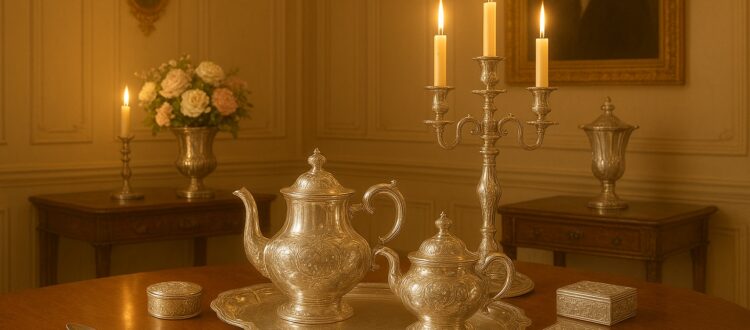The Silver Age: Uncovering the Magic of Georgian Silver
A time of opulence and extravagance, these words best described the Georgian era. While social inequalities grew, those with fortunes did everything to show off their wealth. Fashion, art and architecture flourished. This is the world of Georgian silver, a century‑long story of artistry, innovation, and evolving taste from 1714 to 1830.
The Georgian era, considered a pinnacle of refinement, produced some of the finest silver and other decorative arts ever made.
The various Georgian silver style captures a century of changing taste—from Rococo exuberance to refined Neoclassicism—backed by rigorous silver hallmarking that assures authenticity, craftsmanship, and investment‑grade provenance.
From the refined elegance of silver jewellery to the elaborate designs of decorative arts, the British Georgian silver evolved in style, craftsmanship, and availability, becoming a symbol of status and a testament to the period’s innovation.
For silver lovers and enthusiasts, collecting Georgian silver is a field rich with historical significance. Understanding Georgian silver patterns and styles is key to appreciating its enduring beauty.

The Georgian Era: A Time of Innovation and Change
The Georgian era began with the enthronement of King George Louis of Hanover in 1714.
The Georgian era is thus a time period of British history from 1714-1830, as marked by the reigns of George I, George II, George III, and George IV, the first four Hanoverian kings of Great Britain. The Georgian era’s 116-year span can be divided into the Early Georgian and Late Georgian periods.
Silver in the Georgian Era
Georgian silverware is highly prized because of its quality and design variety. Produced by master silversmiths in London, Dublin, Edinburgh, and provincial workshops, pieces from this period often feature exceptional workmanship.
The Early Georgian period gave birth to styles like the Queen Anne style, marked by simple, elegant forms and minimal decoration, along with the exuberant Baroque and Rococo styles. The Late Georgian period, a Neoclassical style, based on the art and architecture of Ancient Greece and Rome, prevailed.
The Importance of Hallmarks on Georgian Silver

One of the most fascinating aspects of collecting silver is understanding hallmarks. Georgian silver hallmarks, like other British hallmarks, are among the strictest and most detailed in the world, allowing precise dating of antique silver.
Typical hallmarks include:
- Maker’s mark – identifying the silversmith.
- Assay office mark – most often London, Birmingham, Dublin, or Edinburgh.
- Standard mark – usually the lion passant (sterling silver).
- Date letter – a letter corresponding to a specific year.
- Duty mark – a portrait of the reigning monarch (introduced in 1784).
Also Read: A Guide to Decoding Silver Hallmarks
Georgian Silver Styles
Georgian silver has been sought after by collectors for its beautiful design and its superb quality.
Silver of the Georgian period reflects the evolution and progression of fashion and taste. Early George I silver tends towards clean lines, with silver in the late Georgian period leaning towards elaborate as influences from rococo France arrived in London.
- Early Georgian Period
The period began with the lingering influence of the Queen Anne style, characterized by its simplicity and clean, elegant lines. They were characterized by heavy, plain forms and minimal decoration, sometimes incorporating Renaissance/Baroque motifs.
- Rococo

Think movement and drama. Pieces in Rococo style have a sense of fluidity, with swirling “C” and “S” scrolls, naturalistic shell motifs, and floral decorations. These were mainly influenced by Dutch and French decorative arts.
- Neoclassical
This is the style of refined sophistication. A revival of classical Greek and Roman styles, reflected in symmetrical forms and decorative motifs like laurel leaves and scrolls. Common motifs include ribbons, bows, swags, urns, and Greco-Roman figures.
- Regency

Regency silver associated with the classical style, layered with shells, scrolls, lions and other motifs, to create a style emblematic of the world’s most prosperous people. Developed from the Neoclassical style and often seen as a progression towards simpler forms and a refined classicism.
- Gothic Revival & Chinoiserie
Gothic Revival and Chinoiserie were distinct styles that influenced Georgian silver, though Chinoiserie had a more direct and pervasive presence. Chinoiserie was a dominant 18th-century style that integrated European interpretations of Chinese motifs, influencing porcelain and decorative arts.
Types of Georgian Silver Collectibles
Famous Georgian silver collectibles include everything from teaspoons, tea sets, snuff boxes, to candelabras.
- Spoons: Teaspoons and other serving spoons are highly collectible.
- Tea & Coffee Sets: Complete tea and coffee services were status symbols and are prized by collectors today.
- Soup Tureens & Entree Dishes: Large serving pieces like tureens and entree dishes are valuable examples of Georgian silver craftsmanship.
- Sauceboats/Creamboats: These ornate vessels were used for serving sauces and creams during formal meals.
- Sugar Tongs & Tea Strainers: Small but detailed, these items were essential for refined tea ceremonies.
- Candlesticks: Ornate candlesticks were essential for lighting and are sought after for their intricate designs.
- Snuff Boxes: Small, decorative boxes used for carrying snuff, made from silver, gold, or enamel.
- Baby Rattles: Unique items such as the baby rattle from Joseph Taylor, made in 1827, are a testament to Georgian craftsmanship
- Wine Funnels: Elegant and practical dining accessories used to strain wine before serving
- Georgian Silver Jewellery: Much of Georgian jewellery was crafted from Silver, often paired with gorgeous and glittering gemstones, of which Diamonds were a firm favourite.
Also Read: Top 10 Vintage Silver Collectibles
Collecting Georgian Silver Today
The market for collectible Georgian silver remains strong due to its historical importance and enduring beauty. Here are some tips for new and seasoned collectors alike:
- Start small: Flatware, spoons, or vinaigrettes are more affordable entry points.
- Buy from reputable dealers: Always verify Georgian silver hallmarks.
- Look for condition: Patina is natural, but dents, repairs, or over-polishing reduce value.
- Invest in famous makers: Paul de Lamerie, Hester Bateman, and Matthew Boulton pieces command high prices.
- Consider functionality: Georgian silver teapots, candlesticks, and flatware are still usable today, which adds to their appeal.
Conclusion: Why Georgian Silver Endures
The story of Georgian silver is one of artistic brilliance, cultural shifts, and timeless appeal. From the elaborate Rococo forms of the early 1700s to the elegant neoclassical lines of the Regency, Georgian silversmiths captured the spirit of their age in precious metal.
For collectors, the fascination lies not just in the glitter of sterling silver but in the history, it carries—banquets, rituals, and households where these objects once shone.
Whether you’re admiring a Hester Bateman teaspoon or a grand Paul de Lamerie coffee pot, each piece tells a story. The evolution of Georgian silver continues to inspire collectors worldwide, proving that great design never goes out of style.






